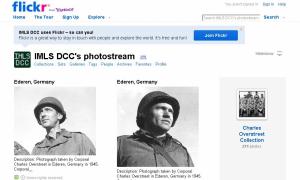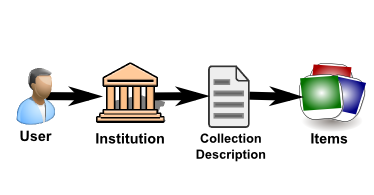A preview of our IMLS DCC Flickr Photostream
Filed under: Flickr Feasibility Study, Interface, Uncategorized | Leave a comment »
A preview of our IMLS DCC Flickr Photostream
Filed under: Flickr Feasibility Study, Interface, Uncategorized | Leave a comment »

IMLS DCC on flickr
We are excited to announce that IMLS DCC has joined Flickr. Our first set of photographs — from Flora (IL) Public Library’s Charles Overstreet Collection — has been uploaded to the photosharing portal as part of the Flickr Feasibility Study (pdf), an IMLS DCC initiative that began this past summer with the goal of increasing the availability and exposure of the rare, historical photos in our collections. We will add to our photostream weekly, so keep checking back for new photos from a variety of collections.
Slated to appear tomorrow in our photostream is a selection from Indiana University’s Charles W. Cushman Photograph Collection, featuring vibrant photos of vintage cars, Chicago’s historic Maxwell Street, and San Francisco in the 1960s.
The Springfield Aviation Company Collection (from Lincoln Library, The Public Library of Springfield, Illinois) and Mining and Mother Jones in Mount Olive (from Mount Olive (IL) Public Library) will contribute photos to our stream over the next few weeks.
Filed under: Flickr Feasibility Study | Leave a comment »
I recently attended the Museums & the Web 2009 conference in Indianapolis, IN. Prof. Mike Twidale and I were there to do a live patchwork prototyping demo of the IMLS DCC Collection Dashboard concept. We had a great crowd of attendees in our booth who provided us with lots of great ideas for next steps (more on that, and a similar demo we did at HASTAC III later). But I also participated in several “unconference” conversations about the semantic web and open/linked data.
At the moment, information from the IMLS DCC is only available via the website and via our OAI-PMH data providers (one for collection-level records, and another for item-level records). While these are great for sharing records between repositories, they don’t necessarily make the information that we have accessible to cool web services like Yahoo! Pipes. Mia Ridge, at the Science Museum in London (and keeper of the Museum API wiki) issued a challenge for us to DO ONE THING before April was over. So here’s my attempt at DOING ONE THING with IMLS DCC. (and is admittedly just a baby step).
One of the services I learned about at MW2009 is Dapper, a tool that will screenscrape HTML pages to produce various kinds of output that you can share with APIs (application program interfaces). Dapper fits nicely within our Patchwork Prototyping toolbox, as it lets us play with some IMLS DCC data in ways that we couldn’t before and without having to actually build an IMLS DCC API first. One of the desirables that came up in both our MW2009 and HASTAC demonstrations was being able to see IMLS DCC collections on a map. So here we go…
First I screenscraped the list of IMLS DCC Collections By Title page. Dapper then allowed me to create:
I took the Atom feed and passed it to the location extractor in Yahoo! Pipes to generate a map.
This is just a first baby step towards building other widgets for a collections dashboard! It needs some work (only a certain number of collections will appear on the map at any one time – you need to browse through the list to see more collections), but the idea behind the DO ONE THING challenge was to take some simple steps to build momentum.
A special thanks to colleague Piotr Adamczyck and his MuseumPipes blog for inspiration!
Filed under: Interface | Tagged: collections dashboard, Dapper, mw2009, Yahoo! Pipes | 2 Comments »
The State Library of Ohio recently added Opening History to the Ohio Digital and Special Collections section of the State Library website.
See their press release for more information about Ohio’s involvement in Opening History.
Filed under: Digital Collection Evalutation (DiCE) | Tagged: Ohio, Publicity | Leave a comment »
The IMLS Digital Collections and Content Interface research group is kicking off a new line of inquiry this week that will explore how we might build a “Collections Dashboard” for the DCC.
According to user studies that we’ve conducted, users rarely find the full-text collection descriptions that we provide very helpful. The long screens of text scare them away and don’t really help them find what they are looking for. In the current iteration of the interface, if I stumble across an interesting item, it can be difficult to even find your way back to a collection-level description. The problem here seems to be that the notion of how and why collection-level descriptions are created is based on an old model that looks like this:

A Traditional Path to Items
But increasingly, the way we find things – particularly in online environments looks more like this:

A Digital Path to Items
Nina Simon takes this notion one step futher, by suggesting that we increasingly come at things indirectly through our social network.
In both of the latter cases a user may lack any understanding of institutional or collection context and may be left wondering just where they’ve ended up. As an aggregation of other people’s metadata, trying to orient the user of an item towards these context can be even more difficult. At present the IMLS DCC contains records from more than 500 collections, 240 different repositories for a total of more than 900,000 item-level metadata records. Simply flattening this out into a large blob of item-level metadata separates items from their contexts. (even Google has its page rank that organizes what appears at the top of your results list according to their place in the networked world).
For certain kinds of users, this kind of context isn’t really what they are interested in. They’ll be happy to find an item and move on to their next search. But for the students and scholars that are our primary focus in this part of the grant, context can be a very important part of their research process. A recent study of scholars who use physical object collection, conducted by the UK’s Research Information Network (RIN), illustrates the problem nicely. Collection-level descriptions, such as those offered by the Cornucopia project, offered insufficient information to meet the scholars needs. But interestingly, this same set of scholars said that item-level descriptions lacked information about contexts that make these items meaningful and valuable for their research. How can we restore that sense of both item-level granularity, while maintaining the rich contexts that these items come from?
One of the main goals of the current phase of the IMLS DCC project (and particularly for the Collection-Item Metadata Relationships research group) has been to take advantage of collection-level and item-level metadata when used together as mutually supportive forms of description. For the interface group, we’ve been asking ourselves what this might mean in light of our usability studies that suggest the long textual descriptions scare people off.
What if we could provide users of the system a quick, easy way to get a 10,000 foot view of a collection? From this vantage point, individual items fall back to reveal the larger contours of a collection landscape. What are the high points? Where are there gaps? Does this look like a promising place to dig deeper for the kinds of items that will answer my research questions? What kind of landscape does this item come from? Will this collection lead me to find other things like it?
When we visit a physical collection all these kinds of information contexts come for free. We know that we’re under the dome of the Library of Congress or foraging in a tightly packed storeroom at the Early American Museum. I can walk down the ranges of my library and count off how many shelves the E 302 Collected Works of American Statesmen takes up. I can gauge how much work it will be to browse through 6 linear feet of archival materials or 600. I know it would take me days, if not weeks to tour the Louvre, but only a few hours to visit my university gallery. In our digital collections it can be hard to tell how vast, how diverse or how cohesive any one collection might be – let alone an aggregation of more than 500.
 In order to do this we’ve borrowed the idea of “information dashboards” that are commonly found in enterprise settings where executives need a high-level overview of underlying processes (see Stephen Few’s book Information Dashboard Design. The Indianapolis Museum of Art was the first to apply this idea in a cultural heritage setting, but like its fore-bearers the IMA dashboard focuses on some of the dynamic processes at work in a museum setting. For the IMLS DCC Collection Dashboard, we’d like to extend this metaphor to represent the key features of a collection in a visualization that is quick and easy to understand.
In order to do this we’ve borrowed the idea of “information dashboards” that are commonly found in enterprise settings where executives need a high-level overview of underlying processes (see Stephen Few’s book Information Dashboard Design. The Indianapolis Museum of Art was the first to apply this idea in a cultural heritage setting, but like its fore-bearers the IMA dashboard focuses on some of the dynamic processes at work in a museum setting. For the IMLS DCC Collection Dashboard, we’d like to extend this metaphor to represent the key features of a collection in a visualization that is quick and easy to understand.
Prof. Mike Twidale and I have setup a temporary demonstration space here where our evolving prototypes will be posted. Watch this blog space for more information and for opportunities to participate virtually in the design. We would particularly like feedback and comments from scholars who use historical collections about what high-level collection features are most useful for assessing a collections value for your research.
You are also invited to participate at the following upcoming conference venues:
Next Post: I’ll talk about the “patchwork prototyping” method we’re using to attack this problem.
Filed under: Dissemination, Interface | Tagged: Collection Dashboard, Patchwork Prototyping | 3 Comments »
You must be logged in to post a comment.